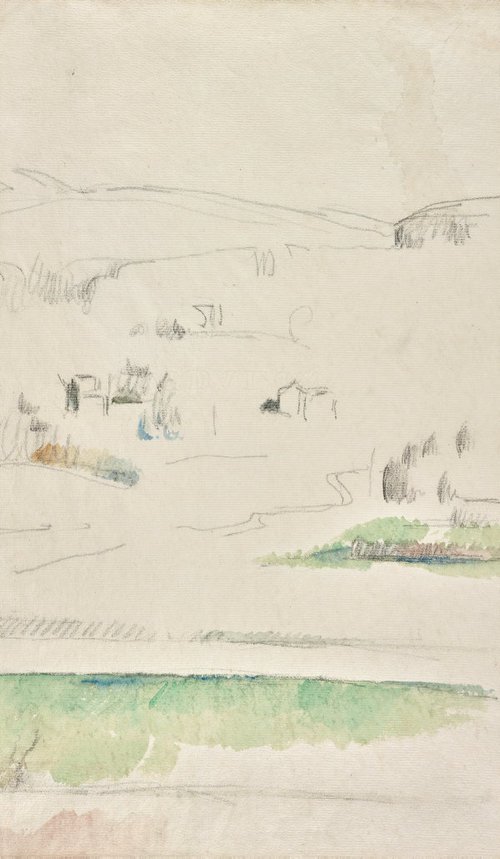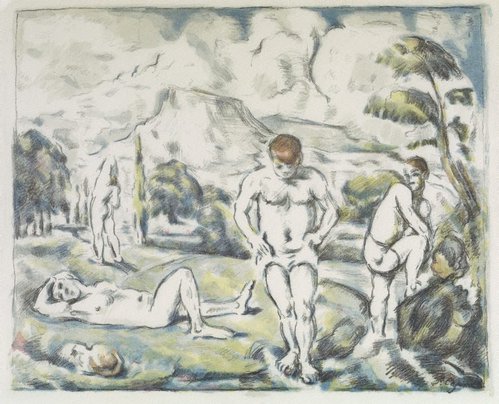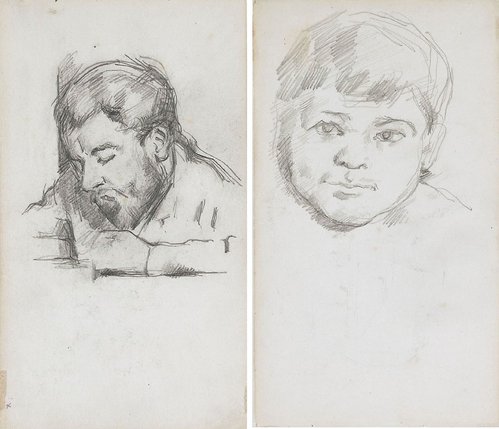-
Details
- Other Titles
- The banks of the Marne
Le chemin de halage sur les bords de la Marne à Créteil
Le Quai du Halage vers Créteil
Maisons au bord de la Marne - Alternative title
- Bords de la Marne
- Date
- circa 1888
- Media category
- Painting
- Materials used
- oil on canvas
- Dimensions
- 65.0 x 81.3 cm strecher; 86.0 x 102.5 x 11.0 cm frame
- Signature & date
Not signed. Not dated.
- Credit
- Purchased 2008 with funds provided by the Art Gallery of New South Wales Foundation, the Art Gallery Society of New South Wales, and donors to the Masterpiece Fund in joint celebration of the Foundation's 25th anniversary and Edmund Capon AM, OBE's 30th anniversary as Director of the Gallery
- Location
- Not on display
- Accession number
- 320.2008
- Copyright
- Artist information
-
Paul Cézanne
Works in the collection
- Share
-
-
About
‘There’s everything in it to please the art lover’. That was the art dealer Ambroise Vollard’s verdict on Cézanne’s painting, ‘Bords de la Marne’. “A river, a boat with people in it, houses in the background, trees,” continued Vollard, who remembered this painting appearing in the first exhibition of Cézanne’s held in his gallery in Paris in 1895.
Vollard remembered it quite accurately: ‘Bords de la Marne’ is a majestically composed landscape which epitomises Cézanne’s classical qualities. Painted on a canvas of his favourite dimensions (63 x 79 cm), Cézanne set out zones of sky, buildings, embankment and water in a sequence of horizontal bands – which is a distinctive mannerism of many of his landscapes.
A horizontal line defines a state of equilibrium. Generally speaking, Cézanne’s art was always a quest for inner balance. In his paintings and drawings “all is connexion, interchange, a ceaselessly shifting and reasserted balance of unbalanced forces,” noted Jack Lindsay. It may come as a surprise to realise that the monumental impression given by ‘Bords de la Marne’ does not depend on any underlying geometrical figures, pre-established proportions or symmetrical arrangement of forms. This pictorial architecture has been intuitively improvised from scratch. The sense of harmony and inevitability it conveys to the viewer is a result of Cézanne’s brilliant instinct for pictorial integration and the infallible plumb-line in his mind’s eye. (Such a keen sensitivity to the inner balance of an image can be regarded as the equivalent, in a visual artist, to the gift of perfect pitch or perfect time in a musician.)
‘Bords de la Marne’ was painted during Cézanne’s “underground” years, a period that extended from 1877 to 1895. He stopped exhibiting in the Impressionists’ group exhibitions, stopped sending paintings to the Salons and virtually dropped out of sight from the Paris art world. “One shouldn’t be astonished that Cézanne hesitated so long and so constantly,” Henri Matisse explained: “There are so many possibilities in him that, more than other artists, he needed to put order into his brain.”
Putting order into his brain meant putting order into his art. Cézanne painted and drew relentlessly. He used this period of his invisibility and anonymity in the art world to consolidate the body of work that would win him acclaim, from 1895 onwards, as the supreme modernist master. Cézanne was fortunate in being financially independent, which relieved him of any thought of painting to please and painting to sell. Such was his disinterestedness, integrity and uncompromisingly sincere commitment to his art that he became a role-model for several generations of modern artists.
Almost every summer he and his family would rent an apartment or take rooms in a hotel somewhere in the Ile-de-France, usually within visiting distance of Impressionist colleagues like Pissarro, Monet or Guillaumin, or near old friends like Emile Zola and Paul Alexis.
‘Bords de la Marne’ was painted not far from the eastern outskirts of Paris. This is a region that has attracted many generations of artists, beginning with Watteau in the 18th century. The Paris-Mulhouse railway line opened in 1854, making the closely adjoining towns of Alfortville, Créteil, Joinville, La Varenne Saint-Hilaire, Chennevières, Saint-Maur, Champigny and Joinville readily accessible to painters from Paris. Corot, Pissarro, Guillaumin and the Douanier Rousseau all painted in or near this cluster of towns. Cartier-Bresson took some famous photographs of working-class picnickers on the banks of the Marne and Jacques Tati filmed ‘Mon Oncle’ in Joinville.
Cézanne must have enjoyed the area very much. There are twenty or so paintings in his catalogue raisonné which may be identified (some more tentatively than others) with sites along the Marne. Due to the fact that Cézanne didn’t sign, date or title his paintings, many aspects of his “underground years” are an insoluble riddle. Nonetheless, John Rewald and Walter Feilchenfeldt, the authors of the catalogue raisonné, propose for the Marne landscapes a range of dates that extend over quite a long period: 1888-90; c.1894; 1895-98; 1904. Although there is an element of guesswork to these dates, they offer proof that Cézanne had a special fondness for this region and returned many times to paint it. The painting ‘Bords de la Marne’, like Cézanne himself, has spent a period of time “underground” – that is to say, it has been out of the public eye. It has been in one family’s private collection for more than a hundred years. Originally it formed part of the legendary Pellerin collection, and has remained until now with Pellerin’s descendants.
Auguste Pellerin made a fortune manufacturing margarine. He began collecting Cézannes in 1899, and it is estimated that at least 150 of Cézanne’s paintings passed through his hands. At its apogee his collection numbered more than a hundred Cézanne paintings as well as some watercolours. His house in Neuilly was visited by various artists, including Paula Modersohn-Becker and Henri Matisse (Matisse painted Pellerin’s portrait in two versions). The magazine L’Amour de l’art, edited by Waldemar George, proposed to reproduce all the Cézannes in Pellerin’s collection and commissioned Roger Fry to write an essay to introduce them. This essay became the basis of Roger Fry’s ‘Cézanne: a Study of His Development’ (1927) which remains among the greatest books ever written about Cézanne.
“M. Pellerin’s collection is so much the most representative of all the various phases of Cézanne’s art in existence, that a study of it is essential to understanding its development,” Fry acknowledged. ‘Bords de la Marne’ was reproduced as Figure 26 within his book.
-
Exhibition history
Shown in 11 exhibitions
Paul Cézanne, Galerie Vollard, Paris, 11 Nov 1895–15 Dec 1895
Hommage à Cézanne, Orangerie des Tuileries, Paris, 02 Jul 1954–17 Oct 1954
Paths to abstraction 1867-1917, Art Gallery of New South Wales, Sydney, 26 Jun 2010–19 Sep 2010
Cézanne. Paris-Provence, National Art Center, Tokyo, Tokyo, 28 Mar 2012–11 Jun 2012
Cézanne Site/Non-site, Museo Thyssen-Bornemisza, Madrid, 04 Feb 2014–18 May 2014
Matisse and the moderns, Art Gallery of New South Wales, Sydney, 25 Apr 2015–25 Oct 2015
Modernists: selections from the European collection, Art Gallery of New South Wales, Sydney, 07 Nov 2015–25 Apr 2016
Landscapes of pleasure, from Monet to Hockney, Art Gallery of New South Wales, Sydney, 30 Apr 2016–17 Jul 2016
Masters of modern art from the Hermitage, Art Gallery of New South Wales, Sydney, 13 Oct 2018–03 Mar 2019
Margaret Olley: a generous life, Queensland Art Gallery/Gallery of Modern Art, Brisbane, 15 Jun 2019–13 Oct 2019
Grand Courts collection rehang, Art Gallery of New South Wales, Sydney, Nov 2021–2023
-
Bibliography
Referenced in 45 publications
-
Art Gallery of New South Wales, Art Gallery of New South Wales annual report 2010–11, Sydney, 2011, pp 10, 72.
-
Art Gallery of New South Wales, Art Gallery of New South Wales annual report 2009–10, Sydney, 2010, p 65, col illus p 43 (in situ).
-
Art Gallery of New South Wales, Art Gallery of New South Wales annual report 2013–14, Sydney, 2014, p 4.
-
Art Gallery of New South Wales, Art Gallery of New South Wales annual report 2012–13, Sydney, 2013, p 5.
-
Art Gallery of New South Wales, Art Gallery of New South Wales annual report 2007–08, Sydney, 2008, pp 13, 17, 56.
-
Art Gallery of New South Wales, Art Gallery of New South Wales annual report 2008–09, Sydney, 2009, pp 6, 14, 16, 21, 62, 63, 74, 85, col illus p 17.
-
Art Gallery of New South Wales, Art Gallery of New South Wales annual report 2011–12, Sydney, 2012, p 92.
-
Philip Bacon, Margaret Olley: a generous life, Brisbane, 2019, pp 188, 201, col illus pp 186 (in situ), 189.
-
Anna Barskaya, Paul Cézanne, 1975, p 173, illus p 174. As 'The banks of the Marne'.
-
Robyn Beckley, Look, 'Member profile', Sydney, Dec 2015-Jan 2016, p 10, col illus p 10 (detail).
-
Edmund Capon, Foundation Newsletter #13, 'Cézanne dream realised', Sydney, Dec 2008, np.
-
Edmund Capon, Look, 'Letter to the Society from Edmund Capon... about the Gallery's Cézanne', Sydney, Mar 2009, pp 10–11, col illus p 11 (installation shot).
-
Nicholas Chambers, Look, 'Morandi meets the Modernists', Sydney, Mar 2016, pp 28–30: p 28.
-
François Chédeville and Raymond Hurtu, Société Cezanne, 'Cezanne sur les bords de la Marne', 21 Sep 2021. As 'Le Quai du Halage à Créteil', 1888–92.
-
Douglas Cooper, The Burlington Magazine, vol 96, no 621, 'Two Cézanne exhibitions - II', London, Dec 1954, pp 378–81, 383: p 379.
-
Denis Coutage, Cézanne and Paris, 'Landscapes of the years 1888–1905', Paris, 2011, pp 134–47: p 138.
-
Denis Coutagne, P. Cézanne à Paris et en Île de France, Marseille, 2011, p 104, col illus p 104. As 'Maison le long du chemin de halage sur les bords de la Marne à Créteil' with old postcard view of motif, dated circa 1894.
-
Denis Coutagne, Cézanne. Paris–Provence, Tokyo, 2012, col illus p 61, no 32.
-
Roger Fry, Cézanne: a study of his development, New York, 1960, pp 61–62, illus pl X, fig 26.
-
Roger Fry, L'Amour de l'Art, vol 7, 'Le développement de Cézanne', Paris, Dec 1926, pp 389–418: pp 406–07, illus p 397. As 'Maisons au bord de la Marne'.
-
Roger Fry, Cézanne: a study of his development, England, 1927, illus pl X, fig 26. (2nd edition London 1932). As 'Maisons au bord de la Marne'.
-
Roger Fry, Samleren, vol 5, 'Cézanne's Udvikling', 1928, pp 101–03, 113–19: illus p 116.
-
Adam Fulton, Sydney Morning Herald, ‘From the natural to the abstract, a momentous evolution’, 25 Jun 2010.
-
Emma Glyde, Look, 'Members' gallery: the next decade', Sydney, Jul 2013, pp 22–30: p 24.
-
Pavel Machotka, Cézanne: landscape into art, 2014, pp 15, 139, col illus p 138, fig 48a. As 'Le Quai du Halage à Créteil'.
-
Terence Maloon, Look, 'A Cézanne for Sydney', Sydney, Oct 2008, pp 28–31: pp 30–31, col illus cover (detail), pp 28–29.
-
Terence Maloon, Paths to abstraction 1867-1917, Sydney, 2010, pp 107, 113, col illus p 113.
-
Lisa-Marie Murphy, Look, 'Building the Gallery's collection', Sydney, Mar 2015, pp 33–34: p 33.
-
Musée de L'Orangerie, Hommage à Cézanne, France, 1954, p 22, no 56, illus pl XXV.
-
Chiara O'Reilly, Journal of the history of collections, vol 32, no 2, 'Collecting French art in the late 1800s at the Art Gallery of New South Wales', Jul 2020, pp 313–25: p 323.
-
Gaëtan Picon, Tout l’œuvre peint de Cézanne, Paris, 1975, p 120, no 735, illus p 119.
-
Maurice Raynal, Initiation à l'art moderne: Cézanne, Paris, 1936, illus p 77, pl 48. (also in English, A Zwemmer, London, 1939 and reprint Skira, Geneva, 1954).
-
John Rewald, The paintings of Paul Cézanne: a catalogue raisonné, New York, 1996, vol 1, p 414, no 628, illus vol 2, p 212, fig 628. As 'Bords de la Marne'.
-
Georges Henri Rivière, Le maître Paul Cézanne, Paris, 1923, p 217, illus opp p 78. As 'Maisons au bord de la Marne, à Créteil'.
-
Birgit Schwarz, Cézanne: Finished, Unfinished, Zurich, 2000, p 380, illus p 380, fig 2. As 'Bords de la Marne'.
-
Guillermo Solana, Cézanne: Site/Non-site, Madrid, 2014, p 182, col illus p 158, no 61.
-
Jill Sykes (Editor), Look, 'Our Cézanne', Sydney, Feb 2009, pp 32–34, col illus p 33.
-
Jill Sykes, Look, 'Those objects of desire: helping to put them in the Gallery collection', Sydney, Mar 2010, p 17.
-
The Art Gallery of New South Wales Foundation and Michael Brand, Art Gallery of New South Wales Foundation: Celebrating 30 years of art acquisitions, Sydney, 2015, pp 6, 37, col illus cover (detail), p 38.
-
Aida Tomescu, Look, 'The art that made me', Sydney, May 2015, pp 14–15: pp 14–15, col illus p 14.
-
Wayne Tunnicliffe, Look, 'Edmund Capon AM OBE, 11 June 1940–13 March 2019', Sydney, May 2019-Jun 2019, pp 20–24: p 22.
-
Lionello Venturi, Cézanne: son art – son oeuvre, Paris, 1936, vol 1, p 202, no 632, illus vol 2, pl 632. (also repr San Francisco 1989). As 'Bords de la Marne'.
-
Ambroise Vollard, Recollections of a picture dealer, 1936, p 74. (also Dover Publications, New York, and in French: Souvenirs d'un marchand de tableaux, Albin Michel, Paris, 1937).
-
Ambroise Vollard, Souvenirs d’un marchand de tableaux, France, 1957, pp 57–59.
-
Judith White, art lovers: the story of the Art Gallery Society of New South Wales 1953-2013, Sydney, 2013, pp 165, 299, col illus p 299. 'Chapter 6: 'Engaging the audience 2000–2012' by Judith White, pp 139–69; 'Acquisitions funded by the Art Gallery Society 1953–2013', pp 192–314.
-
-
Provenance
Ambroise Vollard, pre 1895, Paris/France, with Ambroise Vollard (1866-1939) (dealer) by 1895 and exhibited at the Galerie Vollard in November-December 1895.
Auguste Pellerin, circa 1895-1929, Paris/France, purchased by Auguste Pellerin (1852-1929) from Ambroise Vollard soon after the Cézanne exhibition for 700 francs.
Mme René Lecomte, née Pellerin, 1929, Paris/France, by descent to his daughter Mme René Lecomte, née Pellerin, Paris.
Mr & Mme René Lecomte, 1929-25 Aug 2008, Paris/France, by inheritance to René Lecomte, Paris. Then by descent to the Lecomte family, Paris, until 2008. ('Impressionist and Modern Art (Evening Sale)', Christie's New York, 8 Nov 2000, no 27, bought in). Purchased through Cyrille de Gunzburg, Paris, by the Art Gallery of NSW, 25 August 2008.





